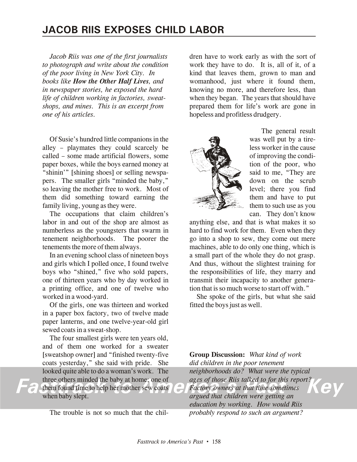| Fasttrack
to America's Past Teacher Key |
|
| Fasttrack
to America's Past Teacher Key |
|
 Page 158 |
Page 158 -
Jacob Riis Exposes Child Labor The reading selection Jacob Riis was a immigrant from Denmark who rose to fame for his photographs and reports about life in the poor sections of New York City in the Gilded Age. His own story after arriving in America in 1870 is remarkable in itself - at one point he was out of work and nearly dead from hunger. He became a newspaper reporter, and once on his feet, he was determined to show conditions at the bottom of American society. His best known book, published in 1890, is titled How the Other Half Lives. The selection condensed in the workbook is from one of his articles about child labor in a poor tenement neighborhood. The interest shown by readers of such reports reveals that the plight of the poor was becoming a concern of the middle and upper classes. The picture A boy selling newspapers in the streets. Cities at that time often had many homeless boys who supported themselves by selling papers and other work. Group discussion question Of the children mentioned in the article, the typical age seems to be between ten and 13 years. What concerned Riis
was not just
that the children were working. Most people at that time did not
have the kind of formal education that is taken for granted
today.
Factory owners even claimed that they were providing an
education.
Riis, however, rejected such claims. The typical work done by
children,
he points out, does not prepare them for anything except "hopeless and
profitless drudgery."
|
|
Copyright Notice
Copyright 2018 by David Burns. All rights reserved. Illustrations and reading selections appearing in this work are taken from sources in the public domain and from private collections used by permission. Sources include: the Dover Pictorial Archive, the Library of Congress, The National Archives, The Hart Publishing Co., Corel Corporation and its licensors, Nova Development Corporation and its licensors, and others. Maps were created or adapted by the author using reference maps from the United States Geological Survey and Cartesia Software. Please see the home page for this title for more information. |